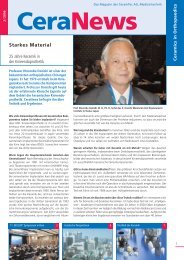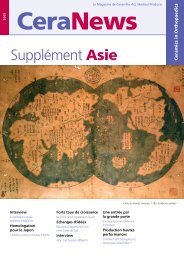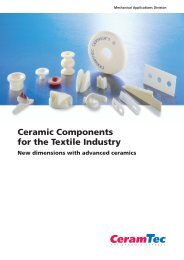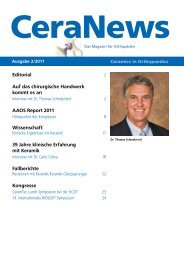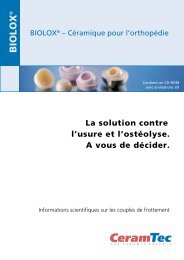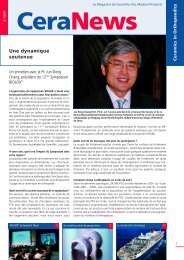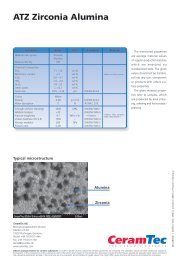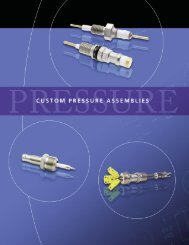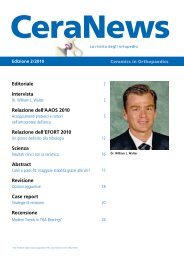Download PDF, 2.4 MB - CeramTec
Download PDF, 2.4 MB - CeramTec
Download PDF, 2.4 MB - CeramTec
You also want an ePaper? Increase the reach of your titles
YUMPU automatically turns print PDFs into web optimized ePapers that Google loves.
and fluid film formation. While larger diameterfemoral ball heads result in less wear, metal wear isbiologically active, with potential consequences assignificant as apoptosis. Local tissue damage due tometal reactivity was evident, primarily when malpositioningcaused excessive wear; on the other hand,metal sensitivity occured regardless of the quantityof particles. The latter manifested itself in the formof lymphocyte stimulation with subsequent boneloss. Particularly with resurfacing, pseudo-tumorformation is marked and is under scrutiny. Knownsystemic effects include elevated serum and urinemetal ion levels and deposition in organs. A potentialcarcinogenic risk cannot ultimately be assessed.Existing study data for modern MoM implants arenot conclusive due to limited patient numbers anddue to the fact that in most cases the follow-upperiod was less than 10 years. In view of the factthat the latency period for tumors is more than 20years, longer follow-up studies with large patientpopulations are required to permit an evaluationof the risk of carcinogenicity. The umbrella termARMD (Adverse Reaction to Metallic Debris) coversmetallosis, pseudo-tumors and ALVAL (Aseptic LymphocyticVasculitis Associated Lesions).Ceramic-on-ceramic (CoC)The CoC bearing couple exhibited the leastamount of wear. It is characterized by its low levelof surface roughness, its hardness and excellentfluid film formation. The result is a high level ofwear resistance. Correct implant positioning isnecessary to avoid any negative impact on theclinical outcome. In this respect, Karachaliospointed out the "chipping" problem, which mayoccur during surgery when positioning ceramicinserts. Noise only occurred in fewer than 1% ofcases. It has many reasons, but they have nowbeen identified. Impingement, edge loading anddisrupted fluid film associated with malpositioningplay a role, as does the vibration behavior ofthe stem, in which case there is evidence that thisis a design-specific problem. Karachalios statedthat the BIOLOX ® delta 4 th generation ceramicshave largely consigned implant fractures as acomplication to history. However, great cautionneeds to be exercised both when handling theceramic components during surgery and implantingthe acetabular cup in the correct position.If these principles are followed, ceramics is thematerial of the future.If these principles are followed, ceramics is the materialof the future.Oxinium *Karachalios remarked that hip simulator resultswith Oxinium femoral ball heads in combinationwith PE and XPE exhibit less wear than the MoPbearing couple. However, there have only beena few clinical results thus far. He reported on thefirst results from his own prospective, randomizedstudy with Oxinium femoral ball heads (28mm,32mm), which exhibited lower wear rates thanCoP or CoXPE. On the other hand, there have beenreports of severe damage to Oxinium femoral ballheads in patients who have experienced recurrentdislocations.Ceramic-on-metal ** (CoM)CoM bearing couples also have only preliminary,short-term clinical results available, albeit with arobust body of experimental data. Clinical studiesare currently in process to evaluate the performanceof the CoM bearing couple.- Theofilos Karachalios, MD* Oxinium is a trademark ofSmith&Nephew** CoM-articulation, Pinnacle ®CoMplete Acetabular HipSystem, DePuy Orthopaedics Inc.Focus on bearing couplesJohn Fisher (UK) spoke about the effect of femoralball head size and material on the onset of wear. Heasserted that hard-on-hard bearings (CoC, MoM)exhibit less wear with increasing head diameter. Inthe hip simulator, the 4 th generation CoC bearingcouple (BIOLOX ® delta) clearly exhibited the lowestlevel of wear, with a volume 50 times lower thanwas observed with the MoXPE bearing couple. TheCoM bearing couple ** still has critical metal wearcompared with the CoC bearing. However, he considersthe possibility of combining a large ceramicfemoral ball head (36mm) with a relatively smallmetal acetabular cup in Asian patients of smallbuild to be an advantage. Nevertheless, the primarygoal must be optimal function and prolongedlongevity. In any case, this requires an optimal positioningof the acetabular cup. Otherwise, the wearrate will be drastically increased.Karl Knahr (Austria) highlighted the risk of fracturesand noise associated with CoC bearing couples.Thanks to developments in the materials used inCeraNews 1/201211



